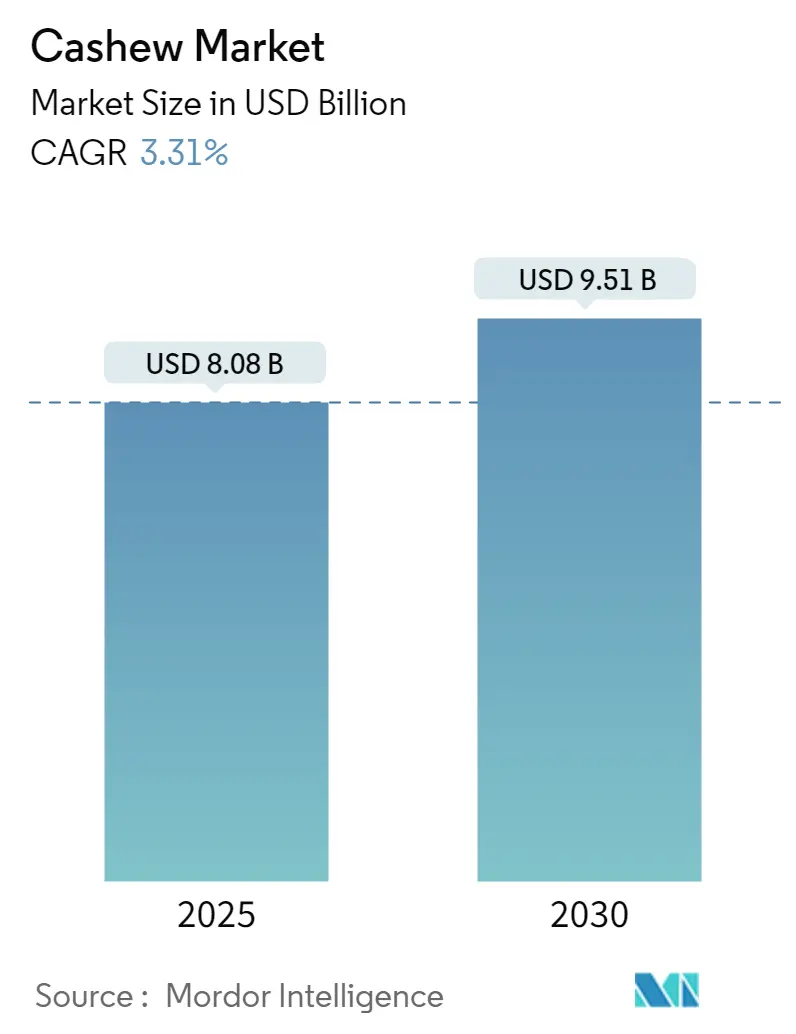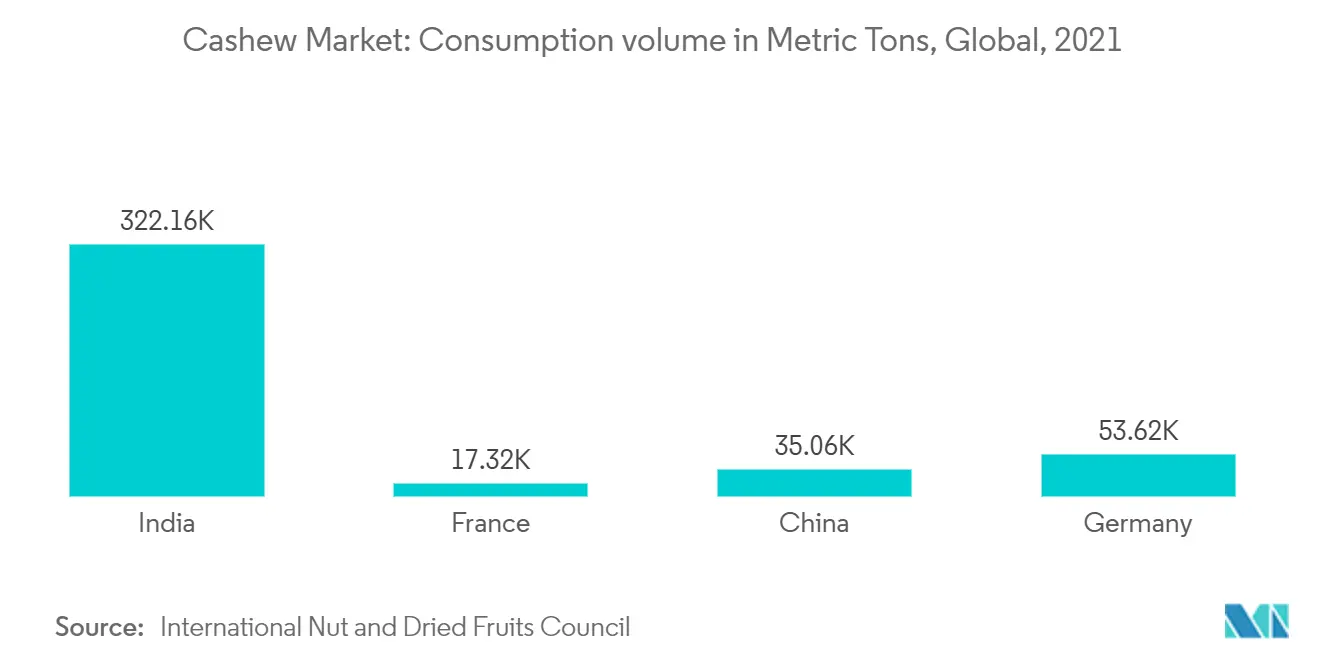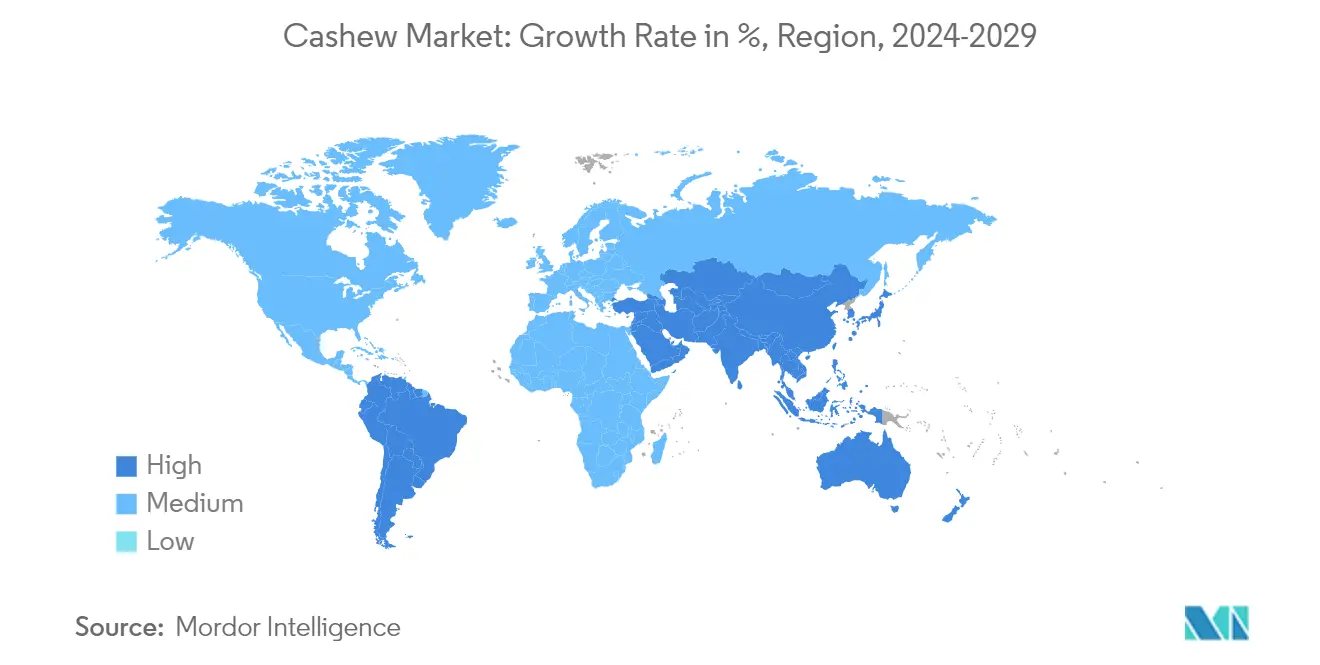
| Study Period | 2019 - 2030 |
| Base Year For Estimation | 2024 |
| Market Size (2025) | USD 8.08 Billion |
| Market Size (2030) | USD 9.51 Billion |
| CAGR (2025 - 2030) | 3.31 % |
| Fastest Growing Market | North America |
| Largest Market | Asia Pacific |
Cashew Market Analysis
The Cashew Market size is estimated at USD 8.08 billion in 2025, and is expected to reach USD 9.51 billion by 2030, at a CAGR of 3.31% during the forecast period (2025-2030).
The cashew market has been growing across the world due to the rising health consciousness and the inclination of people toward healthy food options. Cashew contains healthy carbohydrates, protein, and good fat. Likewise, the cashew is a nutritionally dense food providing a rich source of the B vitamin, vitamin K, and the essential minerals copper, iron, magnesium, manganese, phosphorus, and zinc, which support its consumption by health-conscious people across the world. Multiple benefits of nutrient-rich cashews are aiding the market growth over the forecast period.
- In recent years, there has been a global trend that looks favorably at vegan and plant-based diets. People who embrace a plant-based vegan diet prioritize alternative sources of protein instead of those derived from animals, resulting in the soaring demand for nuts and nut-infused foods, thereby increasing the consumption of cashew nuts globally. For instance, according to a survey conducted by Plant Protein’s sources, the vegan share in the United States drastically increased to 6% in 2022, which is about 19,632,000 vegans.
- In terms of production, according to FAOSTAT, global production of Cashew nuts, in shell was 3,826,874.29 metric tons which increased and reached 3,852,868.11 metric tons in 2022. Further, Côte d’Ivoire, with 970000 metric tons of Cashew nuts, in shell production, ranks first, followed by India, Vietnam, and Tanzania 752000, 341680.33, and 216906.63 metric tons, respectively.
- In addition, the United States is the largest consumer of cashew nuts, followed by Germany, the Netherlands, China, the United Arab Emirates, and the United Kingdom, owing to the increasing health consciousness among people. According to the International Trade Center (ITC), Trademap, in 2022, some major countries from which the United States imports cashews include Vietnam, Cote d’Ivoire, and Brazil. Vietnam constituted the largest exporter of cashews to the United States, accounting for 88.7% in 2022.
Cashew Market Trends
Rising Consumption of Cashew Nuts as a Healthy Snack
- The consumption of cashew nuts has increased in countries such as the United States, China, India, Canada, Thailand, France etc, in recent years. For instance, according to the International Nut and Dried Fruits Council, the per capita consumption of cashews in 2019 was 0.48 kg/year, which increased to 0.54 kg/year by 2021. Moreover, the major reason for increased cashew nut consumption is the health benefits of cashew consumption. Cashew consumption helps lower blood sugar levels, reduce heart disease, weight loss and Type 2 diabetes, and lower cholesterol levels. In addition, the rising population with diseases is promoting the consumption of cashews to prevent diseases and inflammations.
- Although Thailand and India are the major cashew processing countries, imports of shelled cashews grew steadily owing to the domestic demand surpassing the supply in recent years. According to the International Nut and Dried Fruit Council, the estimated per capita consumption in India increased to 0.22 kilograms per year in 2021 from 0.19 in 2019.
- In addition, edible cashews have been used as a snack for a long time. Cashews are also used as one of the main ingredients in preparing various sweet and savory dishes, especially in Asian cuisine. Moreover, cashews are used in mueslis, energy bars, cookies, chocolates, and ice creams. Cashews are known to be high in nutrients, such as copper, which improve bone health, as one ounce of cashew contains 622 micrograms of copper. Nevertheless, cashews have an inflation-driven consumption pattern, as reported by the International Nut and Dried Fruit Council. Thus, the rising consumption of cashew nuts is anticipated to drive the global cashew market during the forecast period.

Asia-Pacific Dominates the Market
- The cashew tree is found worldwide, but it is mostly grown commercially in Northeastern Brazil, Southeast Venezuela, and India. Nowadays, cashew trees grow in other tropical and warm regions, such as Southeast Asia, Africa, and India. More than 80% of cashew cultivation is done by smallholding farms, ranging in size from 0.5 ha to 5 ha in countries of Asia. Medium- and large-scale commercial plantations produce 10-15% of the total production by employing hired laborers in the region.
- Major cashew nut-producing countries in Asia-Pacific are Vietnam, India, Sri Lanka, Indonesia, and the Philippines. The region is the pioneer of cashew trade and processing on the global platform, which drives the market during the forecast period. According to the Food and Agriculture Organization (FAO), India and Vietnam were the two major cashew producers, which accounted for 752,000 metric tons and 341680.33 metric tons, respectively, in 2022.
- Further, Asia-Pacific has been a consistent importer of cashew kernels despite the presence of large cashew-producing countries, such as India and Vietnam, in the region. In terms of consumption, India is the leading country in the world. As Vietnam leads in the production of cashews worldwide, it is also a significant exporter of the same to other international markets.
- Asia-Pacific is one of the largest consumers of cashew nuts in the world. In recent years, there has been an increasing interest in the use of cashew nuts in regular diets and healthy ready-to-eat snacks. The rising number of manufacturers producing innovative cashew-based consumables has taken both young and geriatric consumers by stride. For example, roasted and spice-coated cashew nuts that appeal to the local palate were introduced in India.
- Nuts have become a primary component in the Chinese diet since the inception of the National Health Policy called 'Dietary Guidelines for Chinese Residents,' which emphasizes daily nut consumption. The increased cashew nut imports may also be attributed to the new product campaign of selling 'daily nuts,' including cashews, in ready-to-eat packages, by Chinese nut manufacturers, thus driving the cashew nut market in the country.

Cashew Market News
- January 2023: According to CRISIL (an Indian consulting firm offering ratings, analysis, risk, and policy advice) and a branch of S&P Global, the Indian cashew processing industry is driving demand for cashews, which extended beyond USD 300,000 million in 2022, an increase of 15% year-on-year growth in revenue.
- September 2022: As part of efforts to diversify into other sectors of the economy, the Nigerian Construction Firm Julius Berger Nigeria PLC has unveiled a modern cashew processing plant in Epe, Lagos State, Nigeria. The development helps the company to enter the agriculture produce processing along with improving the cashew processing capacity of the country.
- July 2022: Singapore-based company Royal Nuts has opened its USD 23 million new cashew nut processing plant in Ivory Coast under its subsidiary Dorado Ivory. The new plant is the world's largest cashew processing facility operating at an annual capacity of 75,000 Metric tons. It helps the company to expand its cashew trade and manufacturing business.
Cashew Industry Segmentation
Cashew nuts are edible kidney-shaped nuts, rich in oil and protein, and are roasted and shelled before being eaten. Raw cashew nuts (in-shell) have been considered while collecting data for production. The Global Cashew Nut Market is Segmented by Grade (White Wholes, Scorched Wholes, Dessert Wholes, White Pieces, Scorched Pieces, and Dessert Pieces) and Geography (North America, Europe, Asia-Pacific, South America, and Africa). The report offers the market sizing in terms of volume in metric tons and value in USD.
| Geography | North America | United States | Production Analysis | |
| Consumption Analysis | ||||
| Import Market Analysis | ||||
| Export Market Analysis | ||||
| Price Trend Analysis | ||||
| Regulatory Framework | ||||
| List of Key Players | ||||
| Logistic and Infrastructure | ||||
| Canada | Production Analysis | |||
| Consumption Analysis | ||||
| Import Market Analysis | ||||
| Export Market Analysis | ||||
| Price Trend Analysis | ||||
| Regulatory Framework | ||||
| List of Key Players | ||||
| Logistic and Infrastructure | ||||
| Mexico | Production Analysis | |||
| Consumption Analysis | ||||
| Import Market Analysis | ||||
| Export Market Analysis | ||||
| Price Trend Analysis | ||||
| Regulatory Framework | ||||
| List of Key Players | ||||
| Logistic and Infrastructure | ||||
| Europe | Germany | Production Analysis | ||
| Consumption Analysis | ||||
| Import Market Analysis | ||||
| Export Market Analysis | ||||
| Price Trend Analysis | ||||
| Regulatory Framework | ||||
| List of Key Players | ||||
| Logistic and Infrastructure | ||||
| United Kingdom | Production Analysis | |||
| Consumption Analysis | ||||
| Import Market Analysis | ||||
| Export Market Analysis | ||||
| Price Trend Analysis | ||||
| Regulatory Framework | ||||
| List of Key Players | ||||
| Logistic and Infrastructure | ||||
| France | Production Analysis | |||
| Consumption Analysis | ||||
| Import Market Analysis | ||||
| Export Market Analysis | ||||
| Price Trend Analysis | ||||
| Regulatory Framework | ||||
| List of Key Players | ||||
| Logistic and Infrastructure | ||||
| Asia-Pacific | India | Production Analysis | ||
| Consumption Analysis | ||||
| Import Market Analysis | ||||
| Export Market Analysis | ||||
| Price Trend Analysis | ||||
| Regulatory Framework | ||||
| List of Key Players | ||||
| Logistic and Infrastructure | ||||
| China | Production Analysis | |||
| Consumption Analysis | ||||
| Import Market Analysis | ||||
| Export Market Analysis | ||||
| Price Trend Analysis | ||||
| Regulatory Framework | ||||
| List of Key Players | ||||
| Logistic and Infrastructure | ||||
| Australia | Production Analysis | |||
| Consumption Analysis | ||||
| Import Market Analysis | ||||
| Export Market Analysis | ||||
| Price Trend Analysis | ||||
| Regulatory Framework | ||||
| List of Key Players | ||||
| Logistic and Infrastructure | ||||
| Vietnam | Production Analysis | |||
| Consumption Analysis | ||||
| Import Market Analysis | ||||
| Export Market Analysis | ||||
| Price Trend Analysis | ||||
| Regulatory Framework | ||||
| List of Key Players | ||||
| Logistic and Infrastructure | ||||
| Philippines | Production Analysis | |||
| Consumption Analysis | ||||
| Import Market Analysis | ||||
| Export Market Analysis | ||||
| Price Trend Analysis | ||||
| Regulatory Framework | ||||
| List of Key Players | ||||
| Logistic and Infrastructure | ||||
| Indonesia | Production Analysis | |||
| Consumption Analysis | ||||
| Import Market Analysis | ||||
| Export Market Analysis | ||||
| Price Trend Analysis | ||||
| Regulatory Framework | ||||
| List of Key Players | ||||
| Logistic and Infrastructure | ||||
| South America | Brazil | Production Analysis | ||
| Consumption Analysis | ||||
| Import Market Analysis | ||||
| Export Market Analysis | ||||
| Price Trend Analysis | ||||
| Regulatory Framework | ||||
| List of Key Players | ||||
| Logistic and Infrastructure | ||||
| Argentina | Production Analysis | |||
| Consumption Analysis | ||||
| Import Market Analysis | ||||
| Export Market Analysis | ||||
| Price Trend Analysis | ||||
| Regulatory Framework | ||||
| List of Key Players | ||||
| Logistic and Infrastructure | ||||
| Africa | Côte d'Ivoire (Ivory Coast) | Production Analysis | ||
| Consumption Analysis | ||||
| Import Market Analysis | ||||
| Export Market Analysis | ||||
| Price Trend Analysis | ||||
| Regulatory Framework | ||||
| List of Key Players | ||||
| Logistic and Infrastructure | ||||
| Tanzania | Production Analysis | |||
| Consumption Analysis | ||||
| Import Market Analysis | ||||
| Export Market Analysis | ||||
| Price Trend Analysis | ||||
| Regulatory Framework | ||||
| List of Key Players | ||||
| Logistic and Infrastructure | ||||
Cashew Market Research Faqs
How big is the Cashew Market?
The Cashew Market size is expected to reach USD 8.08 billion in 2025 and grow at a CAGR of 3.31% to reach USD 9.51 billion by 2030.
What is the current Cashew Market size?
In 2025, the Cashew Market size is expected to reach USD 8.08 billion.
Which is the fastest growing region in Cashew Market?
North America is estimated to grow at the highest CAGR over the forecast period (2025-2030).
Which region has the biggest share in Cashew Market?
In 2025, the Asia Pacific accounts for the largest market share in Cashew Market.
What years does this Cashew Market cover, and what was the market size in 2024?
In 2024, the Cashew Market size was estimated at USD 7.81 billion. The report covers the Cashew Market historical market size for years: 2019, 2020, 2021, 2022, 2023 and 2024. The report also forecasts the Cashew Market size for years: 2025, 2026, 2027, 2028, 2029 and 2030.
Our Best Selling Reports
Cashew Industry Report
The global cashew market is experiencing robust growth, driven by diverse consumer needs and applications across various industries such as dairy, bakery, snacks and bars, confectionaries, cereals, beverages, and cosmetics. The market showcases a wide range of product forms including whole, roasted, powder, paste, and splits, making cashews a versatile choice in both culinary and health-focused products. Strengthened by distribution channels like supermarkets and online stores, cashews are increasingly accessible globally, ensuring broad market penetration. Regionally, it spans across major areas including North America, Asia-Pacific, Europe, Latin America, and the Middle East and Africa, thereby contributing extensively to the global demand and supply chain of cashews. Particularly, the demand from the food and beverage sector highlights cashews as a key ingredient, aligning with the rising trend of health-conscious eating and the shift towards plant-based, nutrient-rich food options. This trend not only supports the cashew industry's growth but also positions it well within the competitive landscape where it remains a popular choice for consumers seeking health benefits like cholesterol reduction and heart disease prevention. For further insights into the cashew industry and to learn which region is the largest producer of cashews, download a free report PDF sample from Mordor Intelligence™ Industry Reports.




